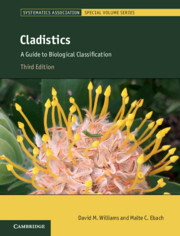Book contents
- Cladistics
- The Systematics Association Special Volume Series
- Cladistics
- Copyright page
- Dedication
- Contents
- Preface
- Acknowledgements
- Introduction: Carving Nature at Its Joints, or Why Birds Are Not Dinosaurs and Men Are Not Apes
- Part I The Interrelationships of Organisms
- Part II Systematics: Exposing Myths
- Part III The Cladistic Programme
- Part IV How to Study Classification
- 8 Modern Artificial Methods and Raw Data
- 9 How to Study Classification: Consensus Techniques and General Classifications
- 10 How to Study Classification: ‘Total Evidence’ vs. ‘Consensus’, Character Congruence vs. Taxonomic Congruence, Simultaneous Analysis vs. Partitioned Data
- 11 How to Study Classification
- 12 How to Study Classification
- Part V Beyond Classification
- Afterword
- Index
- Systematics Association Special Volumes
- References
11 - How to Study Classification
Natural Methods I: Consensus Revisited
from Part IV - How to Study Classification
Published online by Cambridge University Press: 20 July 2020
- Cladistics
- The Systematics Association Special Volume Series
- Cladistics
- Copyright page
- Dedication
- Contents
- Preface
- Acknowledgements
- Introduction: Carving Nature at Its Joints, or Why Birds Are Not Dinosaurs and Men Are Not Apes
- Part I The Interrelationships of Organisms
- Part II Systematics: Exposing Myths
- Part III The Cladistic Programme
- Part IV How to Study Classification
- 8 Modern Artificial Methods and Raw Data
- 9 How to Study Classification: Consensus Techniques and General Classifications
- 10 How to Study Classification: ‘Total Evidence’ vs. ‘Consensus’, Character Congruence vs. Taxonomic Congruence, Simultaneous Analysis vs. Partitioned Data
- 11 How to Study Classification
- 12 How to Study Classification
- Part V Beyond Classification
- Afterword
- Index
- Systematics Association Special Volumes
- References
Summary
In Chapter 7 we noted that ‘the single most important principle of cladistics is that diverse fundamental cladograms may be combined to form a single general cladogram’ (Nelson 1979, p. 7) and that while the construction of general cladograms may related to consensus methods they are not necessarily the product of any particular kind of consensus method. We have discussed a few elements of consensus methods in Chapter 9. Below we pursue one version in a little more detail.
Information
- Type
- Chapter
- Information
- CladisticsA Guide to Biological Classification, pp. 273 - 286Publisher: Cambridge University PressPrint publication year: 2020
